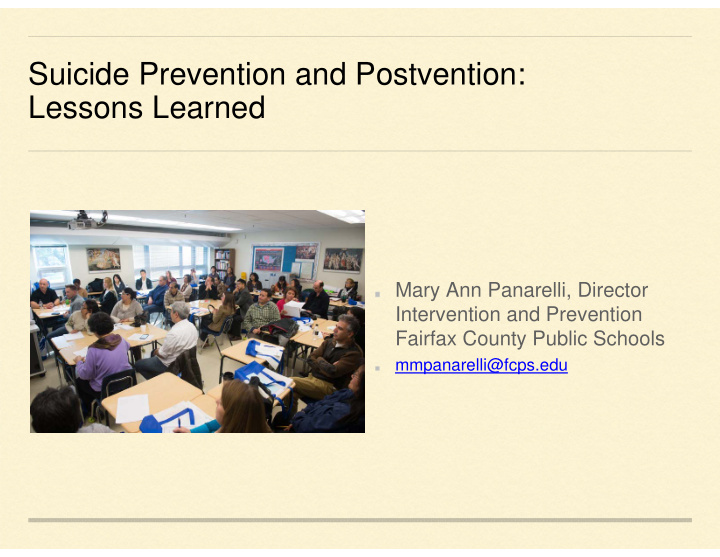



Suicide Prevention and Postvention: Lessons Learned Mary Ann Panarelli, Director Intervention and Prevention Fairfax County Public Schools mmpanarelli@fcps.edu
PRESENTATION OVERVIEW Overview of the district, pre-existing school programs to enhance mental health Recognition and response to an increased incidence of teen suicides Collaborative intervention and response from schools and community Gatekeeper training Teen suicide in age of social media
FAIRFAX COUNTY PUBLIC SCHOOLS 10th largest school division in the country Primarily suburban, 407 square miles Diverse student population - 186,000 students, 196 schools - 10% Black, 25% Hispanic - 20% Asian, 40%White - 5% multiracial - 48% speak a language other than English in the home
CONCERN ABOUT YOUTH SURVEY DATA 32% report feeling so sad and hopeless over two week period that they could not do normal activities 50% of Hispanic females report these depressive feelings 17% of teens surveyed report considering suicide 48% report being bullied Lower than national averages, but still high numbers of students report use of alcohol and other drugs, intimate partner violence and exposure to domestic violence
YOUTH SURVEY ASSETS Direct relationship between youth who report that they have three or more assets and reduced report of depressive or suicidal thinking Involved in community service Involved in extracurricular activities High personal integrity Parent available to help when needed Adult in community available to help Teachers know me and notice when I do good work
RESILIENCY PROJECT http://www.fcps.edu/dss/ips/resiliency/rb.shtml Coordinated resiliency-based approach by counselors, psychologists, social workers to common adversity experienced by school-age youth Bullying prevention and intervention Depression awareness and suicide prevention Systematic evaluation and response to threats Crisis response following death of student, teacher or administrator, including postvention following suicide
OTHER SCHOOL EFFORTS Universal lessons in Health (middle and high) and counseling (elementary) Use of Signs of Suicide (SOS) program and screener Parent Clinic-a summer offer to any parent to make an appointment to consult privately with a school psychologist or social worker for an hour Student led Wellness Weeks to introduce prevention and stress reduction activities Partnerships established with county youth serving agencies and non- profit groups
2012-2014 INCREASED CONCERN ABOUT TEEN SUICIDE One high school had 7 teens die by suspected suicide in 3 years (2012-2014) Overall county teen suicide rate increased during 2012-2014 In both February 2014, and September 2014 there were 4 suspected suicides during the month
POSTVENTION PLUS • Suicide prevention experts consulted • Parent information evening with mental health resources • A student response team and additional clinical support and professional development provided via a SAMHSA grant • Climate survey, pilot online gatekeeper training, pilot crisis text line at target schools • Epi-Aid completed by Center for Disease Control at request of Health Department
PARTNERSHIP ACROSS COMMUNITY Community Services Board Neighborhood and Community Services Parent groups- Community of Solutions NAMI, Josh Anderson Foundation, American Foundation for Suicide Prevention
ONGOING SCHOOL RESPONSE Crisis numbers posted on every school website Keep in Touch messages sent to parents and students prior to school holidays and exams, providing names of clinical team at school and community resources Youth clubs and leadership classes engaged to develop mental health initiatives to reduce stigma and open conversation with adults Over 18,000 teachers, coaches, staff completed At Risk Increased use of Employee Assistance Program Counselors
COMMUNITY SERVICES BOARD (CSB) Expansion of Youth Mobile Crisis response Initiation of program to address first time psychotic episodes Expansion of outpatient and emergency services for youth Contest for video messages for youth by youth www. youtube .com/watch?v=ika2Vfz-R_k
CSB AND FCPS PARTNERSHIP CSB therapists provided counseling in community settings following teen death CSB created a cohort of Youth Mental Health First Aid trainers, including 20 school psychologists and school social workers Collaboratively developed a Crisis Text line for FCPS students, and a separate line for community members Funded an online, immersive simulation training for gatekeepers in school and community ( At Risk )
COMMUNITY PARTNERS Annual Community Conversation on Teen Stress Fairfax Mental Health Promotion Committee Northern Virginia Regional Suicide Prevention Taskforce Suicide review team Workshops and events for parents and youth group leaders sponsored by private providers and non-profits Stress Less Days – seated massage, yoga, food for teachers; youth led activities, yoga, mindfulness, singing, dancing, therapy dogs for kids Funding provided to youth led school programs and PSA
NEXT STEPS Exploring ways to “pre-certify” private practice providers to assist in crisis response or depression screenings Added questions on Youth Survey; added domestic violence questions to suicide risk assessment Project AWARE and Climate Transformation grant Short-Term Behavioral Health Service Program Behavioral Health System of Care Blueprint
Recommend
More recommend